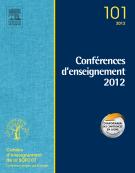La rupture du LCA : ACL rupture - 14/11/13
| pagine | 11 |
| Iconografia | 12 |
| Video | 0 |
| Altro | 0 |
Résumé |
L’évolution des reconstructions du ligament croisé antérieur (LCA) a été considérable au cours de ces 30 dernières années. C’est une meilleure connaissance de l’anatomie qui a permis les progrès avec la description des insertions fémorales et tibiales de deux faisceaux. L’intervention de référence remonte aux années 1980, avec la reconstruction du faisceau antéromédial utilisant le tiers moyen du ligament patellaire. L’insuffisance du contrôle des rotations obtenu avec cette intervention nous a fait évoluer vers une technique plus anatomique reconstruisant les faisceaux antéromédial et postérolatéral. Celle-ci nous a permis de réfléchir aux reconstructions de l’un des deux faisceaux en cas de rupture partielle, puis à des techniques préservant au maximum les tissus résiduels du LCA. Aujourd’hui, les techniques de reconstruction ne sont pas univoques mais dépendent de l’analyse précise du type de lésion et des résidus de LCA persistant dans l’échancrure intercondylienne.
Abstract – Acl rupture
Anterior cruciate ligament reconstruction has evolved considerably over the past 30 years. A better understanding of the ACL anatomy and, first of all, a precise description of the femoral and tibial insertions of its two bundles has allowed for considerable improvement in the surgical reconstruction. In the 80s, the gold standard was reconstruction of the anteromedial bundle using the middle third of the patellar ligament. Insufficient control of the rotatory laxity has led to a modification of our techniques with the development of double bundle ACL reconstruction. Based on the double bundle concept and on the growing interest in preserving any ACL remnants, selective reconstruction in case of partial rupture or biological reconstruction using an ACL remnant has emerged. Current ACL reconstructions are not uniform; they depend on the type of lesion and on the aspect of the ACL remnant in the intercondylar notch.
Mappa
© 2012 Elsevier Masson SAS. Tutti i diritti riservati.© 2012 Centre orthopédique Santy, Lyon, France.. Pubblicato da Elsevier Masson SAS. Tutti i diritti riservati.
Benvenuto su EM|consulte, il riferimento dei professionisti della salute.
L'accesso al testo integrale di questo articolo richiede un abbonamento o un acquisto all'unità.
Benvenuto su EM|consulte, il riferimento dei professionisti della salute.
L'accesso al testo integrale di questo articolo richiede un abbonamento.
Già abbonato a questo prodotto ?


